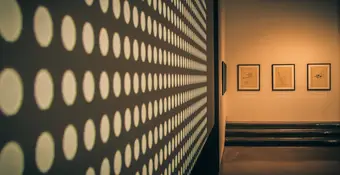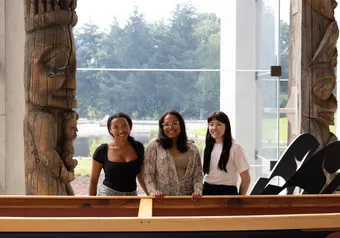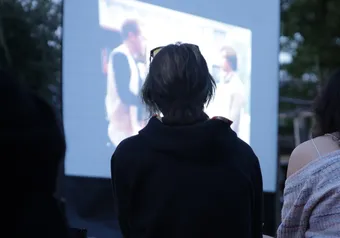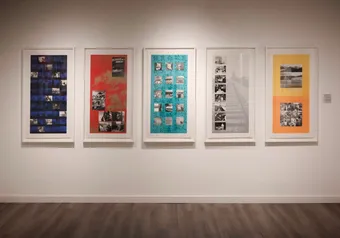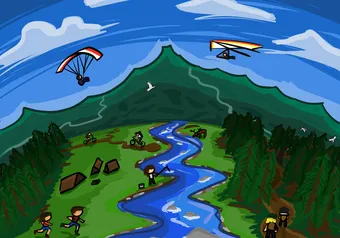This summer, the Richmond Art Gallery is hosting The Roaming Peach Blossom Spring from June 28 to August 24. Curated by Rebecca Wang 王晨釔, the exhibition features work by Shanghai-based artist Qiu Anxiong and Vancouver-based artist Howie Tsui.
Works by both artists are installed throughout the space. Anxiong’s animation project, The New Book of Mountains and Seas is displayed on a customized small 6.5 meter screen. One of the first elements visible is a set of light boxes featuring lenticular prints — images that shift depending on the viewing angle. The gallery shares space with a separate exhibition, Enigmas & Dreams: Works on Paper by Chinese Canadian artists Alvin Jang & Anna Wong.
“The Peach Blossom Spring,” for which the exhibition is named, is a famous fable from fifth century China about the search for a surreal utopia. The phrase is sometimes used to describe an idealistic place or an unreachable dream.
“[The exhibition is] about the fantastical worlds that [the artists] create in which they re-imagine contemporary events through mythology and martial arts fiction,” Wang said. “They also complicate the idea of longing for refuge or searching for sanctuary by presenting a world that is both utopian and dystopian.”
Wang said that her addition of the word “roaming” to the exhibition’s title represents the diasporic experience. This focus on the diaspora came naturally, she said, “because [her] own artistic and curatorial practice both deal with diasporic identities.”
Currently pursuing a master’s in critical and curatorial studies at UBC, Wang curated the exhibition as part of her program’s practicum component, which requires students to organize an exhibition from start to finish. This includes drafting a proposal, finding a venue, inviting artists and submitting a paper about the curatorial process.
The spirit of Wang’s curatorial work draws “references [from] artistic techniques and philosophical thought from the Song Dynasty,” of which her hometown, Hangzhou, was the historic capital.
Anxiong’s animation, a foundational element of the exhibition, is primarily expressionistic in nature, relying on visual allegory and symbolic imagery to explore environmental and civilizational themes.
He draws inspiration from The Book of Mountains and Seas, known also as Shan Hai Jing, a collection of mythological and geographical texts from China, dating back as early as the fourth century BCE. His work keeps the spirit of the classic, while adapting it to contemporary concerns and the medium of animation.
While planning her exhibition, Wang decided to reach out to Anxiong because she had written a research paper on his work in 2023.
“I didn't know I was going to do an exhibition on his work [at the time], but later, when I started to brainstorm for the project, I was like, already, there's so much research on this artist and work, why not try to reach out to ask,” she said.
“When [Anxiong] was in university in the early 90’s in China, he intentionally embraced everything Western as was the ethos of the time because it was assumed to be better”, said Wang. “After the six years he spent in Germany, he was re-drawn to classical Chinese texts and the traditional art forms.”
A section of the exhibition features prints of fantastical creatures from Anxiong’s The New Book of Mountains and Seas. The creatures are portrayed as if glimpsed for the first time in distant, mythical lands. Each print is embedded with an inscription written in classical Chinese, with English translations provided beside the artwork. The descriptions evoke the tone of ancient chronicles.
Tsui’s pieces draw on a different aspect of cultural memory. Born in Hong Kong and raised in Nigeria and Canada, his work heavily references Hong Kong films and TV series, particularly the wuxia (martial arts) genre.
Wang explained that Tsui employs the wuxia genre to reclaim vanishing Hong Kong landmarks, as arenas of martial arts fantasy and resistance, offering a subtle critique of cultural erasure. For example, in Tsui’s work "JUMBO," he reimagines the martial wuxia of novels such as the Condor Trilogy within the vanished Kowloon Walled City of Hong Kong and the floating restaurant Jumbo Kingdom.
Tsui’s works feature a multitude of unusual different art mediums. “Spectral Residue” stands out in particular, for its use of incense smoke along with ink and paint. The floor in front of the piece was full of burnt matches, leaving a tangible piece of the artistic process for viewers to look at.
Together, the works in The Roaming Peach Blossom Spring offer a timely reflection on identity, displacement
For Wang, the exhibition represents not just an academic milestone, but a personal and curatorial exploration of diasporic experience and one that continues to evolve across borders, mediums and generations.
First online , last modified
Share this article


